Management Accounting Report: Techniques and Financial Reporting
VerifiedAdded on 2020/12/10
|18
|4484
|236
Report
AI Summary
This report delves into the core principles and applications of management accounting within the context of ABC Ltd. It explores essential requirements of different management accounting systems, including cost accounting, inventory management, job costing, and price optimization. The report details various management accounting reporting methods such as performance reports, cost managerial accounting reports, budget reports, and account receivable aging reports. It evaluates the benefits of a management accounting system, highlighting its application in organizations like ABC Ltd. The report also covers the calculation of costs using marginal and absorption costing techniques, along with the application of a range of management accounting techniques and producing appropriate financial reporting documents. Furthermore, it examines different types of planning tools used for budgetary control, their advantages, and disadvantages, and how organizations adapt management accounting systems to respond to financial problems. The analysis provides a comprehensive understanding of how management accounting aids in financial decision-making, cost control, and strategic planning within a business context.
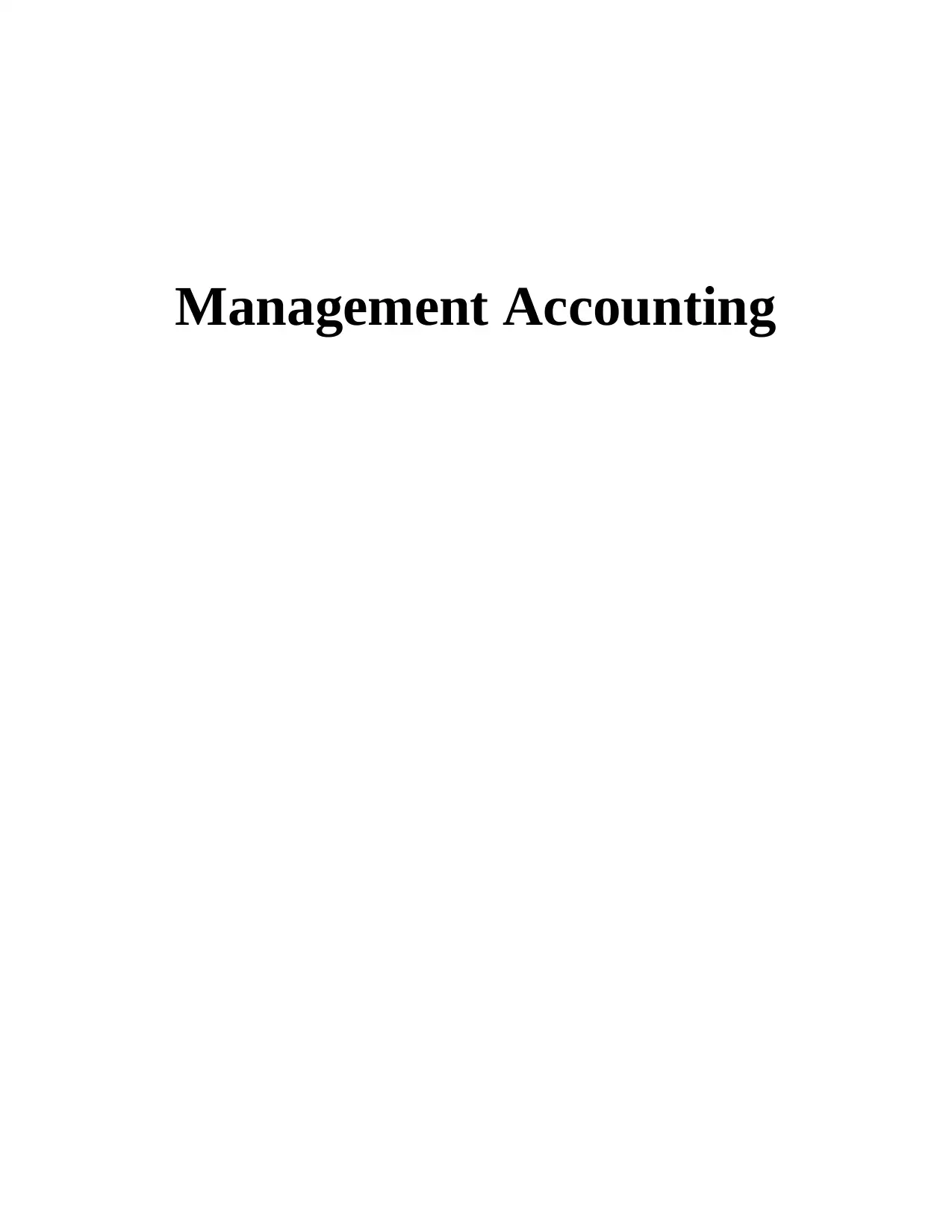
Management Accounting
Paraphrase This Document
Need a fresh take? Get an instant paraphrase of this document with our AI Paraphraser
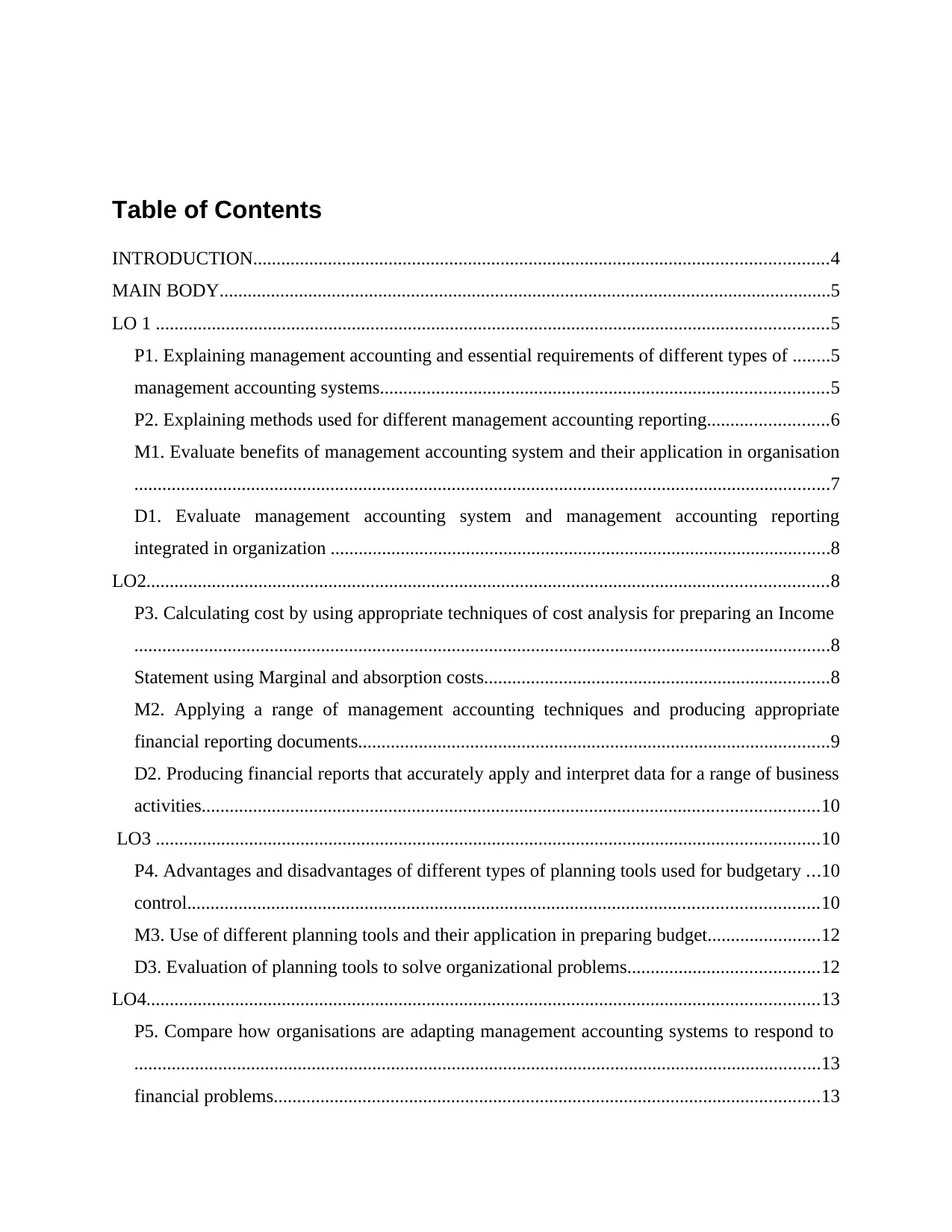
Table of Contents
INTRODUCTION...........................................................................................................................4
MAIN BODY...................................................................................................................................5
LO 1 ................................................................................................................................................5
P1. Explaining management accounting and essential requirements of different types of ........5
management accounting systems................................................................................................5
P2. Explaining methods used for different management accounting reporting..........................6
M1. Evaluate benefits of management accounting system and their application in organisation
.....................................................................................................................................................7
D1. Evaluate management accounting system and management accounting reporting
integrated in organization ...........................................................................................................8
LO2..................................................................................................................................................8
P3. Calculating cost by using appropriate techniques of cost analysis for preparing an Income
.....................................................................................................................................................8
Statement using Marginal and absorption costs..........................................................................8
M2. Applying a range of management accounting techniques and producing appropriate
financial reporting documents.....................................................................................................9
D2. Producing financial reports that accurately apply and interpret data for a range of business
activities....................................................................................................................................10
LO3 ..............................................................................................................................................10
P4. Advantages and disadvantages of different types of planning tools used for budgetary ...10
control.......................................................................................................................................10
M3. Use of different planning tools and their application in preparing budget........................12
D3. Evaluation of planning tools to solve organizational problems.........................................12
LO4................................................................................................................................................13
P5. Compare how organisations are adapting management accounting systems to respond to
...................................................................................................................................................13
financial problems.....................................................................................................................13
INTRODUCTION...........................................................................................................................4
MAIN BODY...................................................................................................................................5
LO 1 ................................................................................................................................................5
P1. Explaining management accounting and essential requirements of different types of ........5
management accounting systems................................................................................................5
P2. Explaining methods used for different management accounting reporting..........................6
M1. Evaluate benefits of management accounting system and their application in organisation
.....................................................................................................................................................7
D1. Evaluate management accounting system and management accounting reporting
integrated in organization ...........................................................................................................8
LO2..................................................................................................................................................8
P3. Calculating cost by using appropriate techniques of cost analysis for preparing an Income
.....................................................................................................................................................8
Statement using Marginal and absorption costs..........................................................................8
M2. Applying a range of management accounting techniques and producing appropriate
financial reporting documents.....................................................................................................9
D2. Producing financial reports that accurately apply and interpret data for a range of business
activities....................................................................................................................................10
LO3 ..............................................................................................................................................10
P4. Advantages and disadvantages of different types of planning tools used for budgetary ...10
control.......................................................................................................................................10
M3. Use of different planning tools and their application in preparing budget........................12
D3. Evaluation of planning tools to solve organizational problems.........................................12
LO4................................................................................................................................................13
P5. Compare how organisations are adapting management accounting systems to respond to
...................................................................................................................................................13
financial problems.....................................................................................................................13
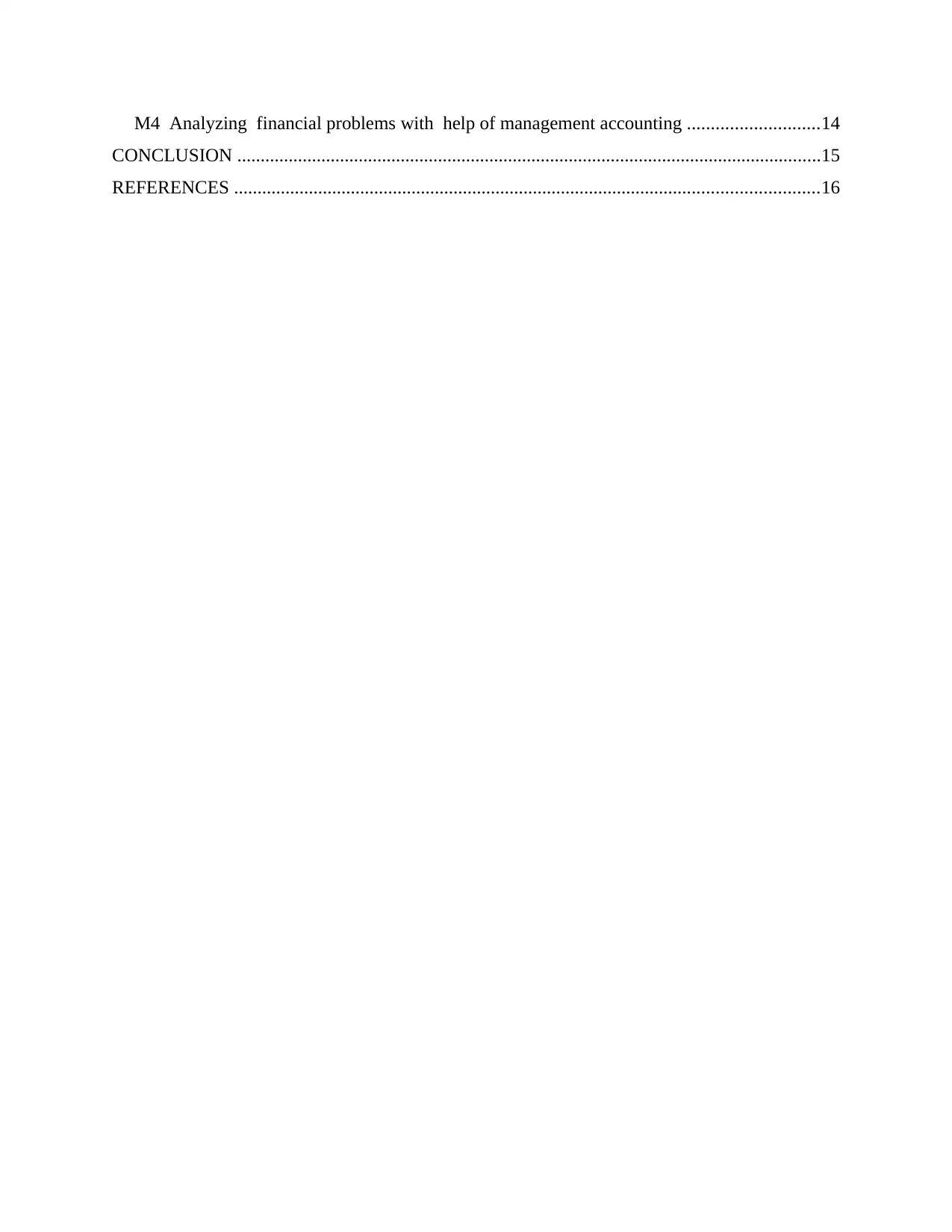
M4 Analyzing financial problems with help of management accounting ............................14
CONCLUSION .............................................................................................................................15
REFERENCES .............................................................................................................................16
CONCLUSION .............................................................................................................................15
REFERENCES .............................................................................................................................16
⊘ This is a preview!⊘
Do you want full access?
Subscribe today to unlock all pages.

Trusted by 1+ million students worldwide
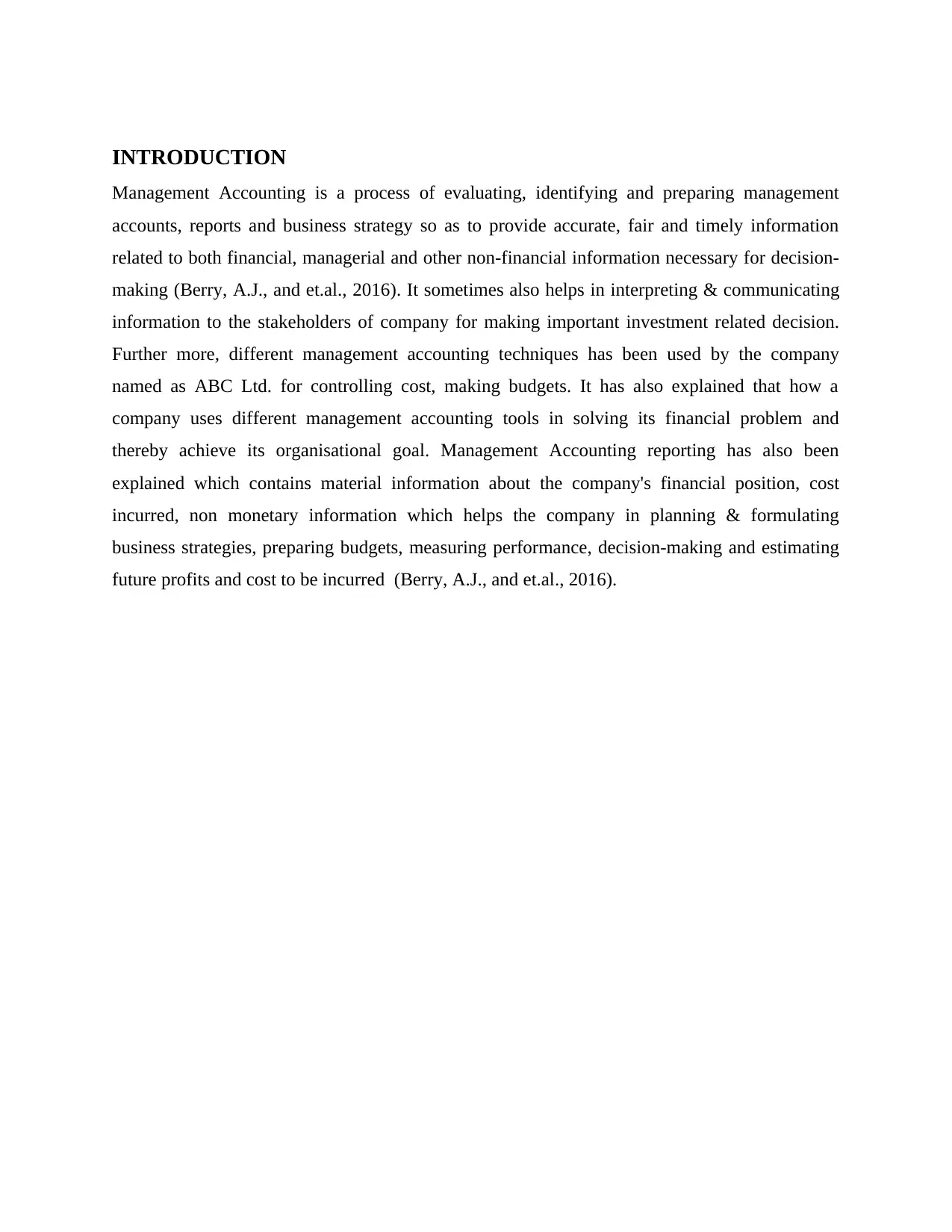
INTRODUCTION
Management Accounting is a process of evaluating, identifying and preparing management
accounts, reports and business strategy so as to provide accurate, fair and timely information
related to both financial, managerial and other non-financial information necessary for decision-
making (Berry, A.J., and et.al., 2016). It sometimes also helps in interpreting & communicating
information to the stakeholders of company for making important investment related decision.
Further more, different management accounting techniques has been used by the company
named as ABC Ltd. for controlling cost, making budgets. It has also explained that how a
company uses different management accounting tools in solving its financial problem and
thereby achieve its organisational goal. Management Accounting reporting has also been
explained which contains material information about the company's financial position, cost
incurred, non monetary information which helps the company in planning & formulating
business strategies, preparing budgets, measuring performance, decision-making and estimating
future profits and cost to be incurred (Berry, A.J., and et.al., 2016).
Management Accounting is a process of evaluating, identifying and preparing management
accounts, reports and business strategy so as to provide accurate, fair and timely information
related to both financial, managerial and other non-financial information necessary for decision-
making (Berry, A.J., and et.al., 2016). It sometimes also helps in interpreting & communicating
information to the stakeholders of company for making important investment related decision.
Further more, different management accounting techniques has been used by the company
named as ABC Ltd. for controlling cost, making budgets. It has also explained that how a
company uses different management accounting tools in solving its financial problem and
thereby achieve its organisational goal. Management Accounting reporting has also been
explained which contains material information about the company's financial position, cost
incurred, non monetary information which helps the company in planning & formulating
business strategies, preparing budgets, measuring performance, decision-making and estimating
future profits and cost to be incurred (Berry, A.J., and et.al., 2016).
Paraphrase This Document
Need a fresh take? Get an instant paraphrase of this document with our AI Paraphraser
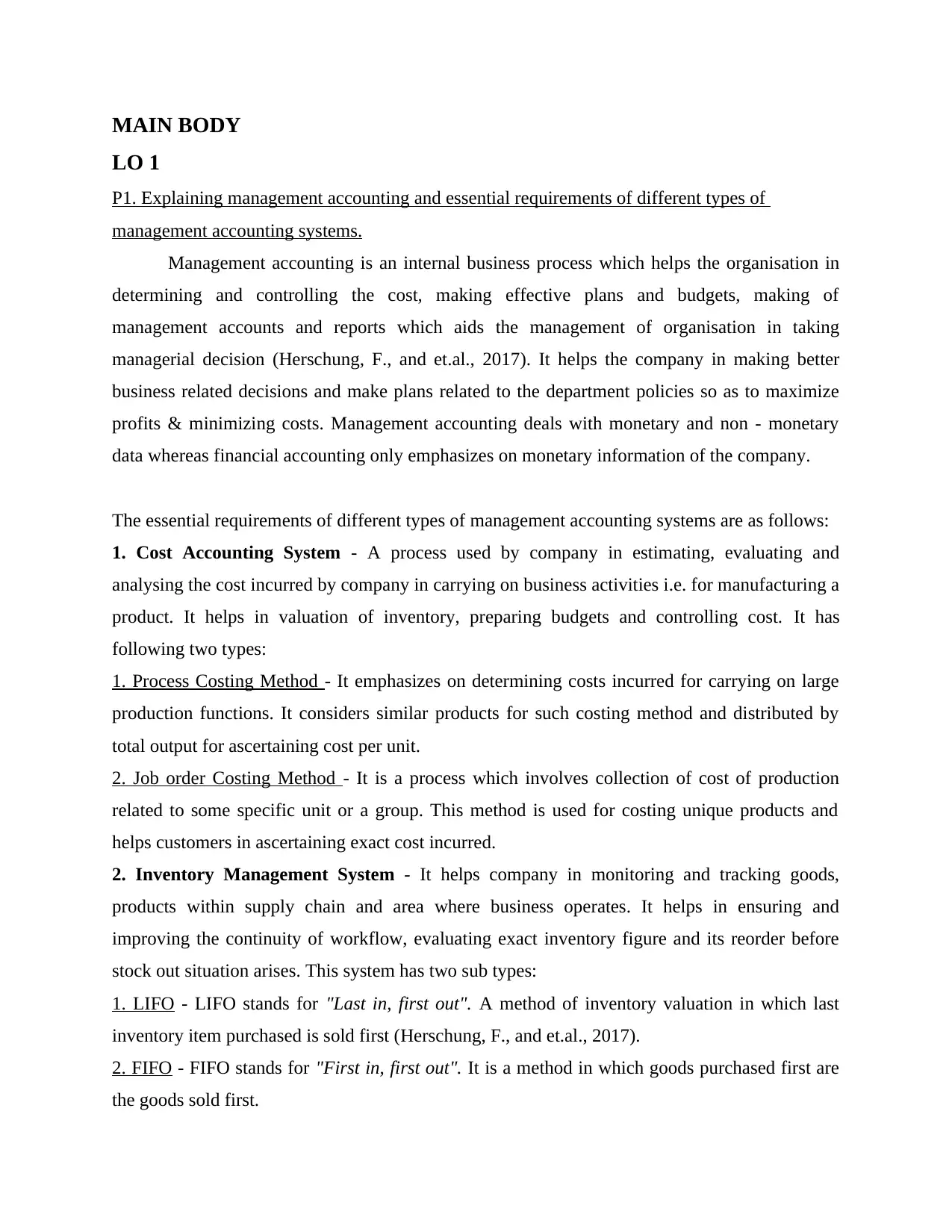
MAIN BODY
LO 1
P1. Explaining management accounting and essential requirements of different types of
management accounting systems.
Management accounting is an internal business process which helps the organisation in
determining and controlling the cost, making effective plans and budgets, making of
management accounts and reports which aids the management of organisation in taking
managerial decision (Herschung, F., and et.al., 2017). It helps the company in making better
business related decisions and make plans related to the department policies so as to maximize
profits & minimizing costs. Management accounting deals with monetary and non - monetary
data whereas financial accounting only emphasizes on monetary information of the company.
The essential requirements of different types of management accounting systems are as follows:
1. Cost Accounting System - A process used by company in estimating, evaluating and
analysing the cost incurred by company in carrying on business activities i.e. for manufacturing a
product. It helps in valuation of inventory, preparing budgets and controlling cost. It has
following two types:
1. Process Costing Method - It emphasizes on determining costs incurred for carrying on large
production functions. It considers similar products for such costing method and distributed by
total output for ascertaining cost per unit.
2. Job order Costing Method - It is a process which involves collection of cost of production
related to some specific unit or a group. This method is used for costing unique products and
helps customers in ascertaining exact cost incurred.
2. Inventory Management System - It helps company in monitoring and tracking goods,
products within supply chain and area where business operates. It helps in ensuring and
improving the continuity of workflow, evaluating exact inventory figure and its reorder before
stock out situation arises. This system has two sub types:
1. LIFO - LIFO stands for "Last in, first out". A method of inventory valuation in which last
inventory item purchased is sold first (Herschung, F., and et.al., 2017).
2. FIFO - FIFO stands for "First in, first out". It is a method in which goods purchased first are
the goods sold first.
LO 1
P1. Explaining management accounting and essential requirements of different types of
management accounting systems.
Management accounting is an internal business process which helps the organisation in
determining and controlling the cost, making effective plans and budgets, making of
management accounts and reports which aids the management of organisation in taking
managerial decision (Herschung, F., and et.al., 2017). It helps the company in making better
business related decisions and make plans related to the department policies so as to maximize
profits & minimizing costs. Management accounting deals with monetary and non - monetary
data whereas financial accounting only emphasizes on monetary information of the company.
The essential requirements of different types of management accounting systems are as follows:
1. Cost Accounting System - A process used by company in estimating, evaluating and
analysing the cost incurred by company in carrying on business activities i.e. for manufacturing a
product. It helps in valuation of inventory, preparing budgets and controlling cost. It has
following two types:
1. Process Costing Method - It emphasizes on determining costs incurred for carrying on large
production functions. It considers similar products for such costing method and distributed by
total output for ascertaining cost per unit.
2. Job order Costing Method - It is a process which involves collection of cost of production
related to some specific unit or a group. This method is used for costing unique products and
helps customers in ascertaining exact cost incurred.
2. Inventory Management System - It helps company in monitoring and tracking goods,
products within supply chain and area where business operates. It helps in ensuring and
improving the continuity of workflow, evaluating exact inventory figure and its reorder before
stock out situation arises. This system has two sub types:
1. LIFO - LIFO stands for "Last in, first out". A method of inventory valuation in which last
inventory item purchased is sold first (Herschung, F., and et.al., 2017).
2. FIFO - FIFO stands for "First in, first out". It is a method in which goods purchased first are
the goods sold first.
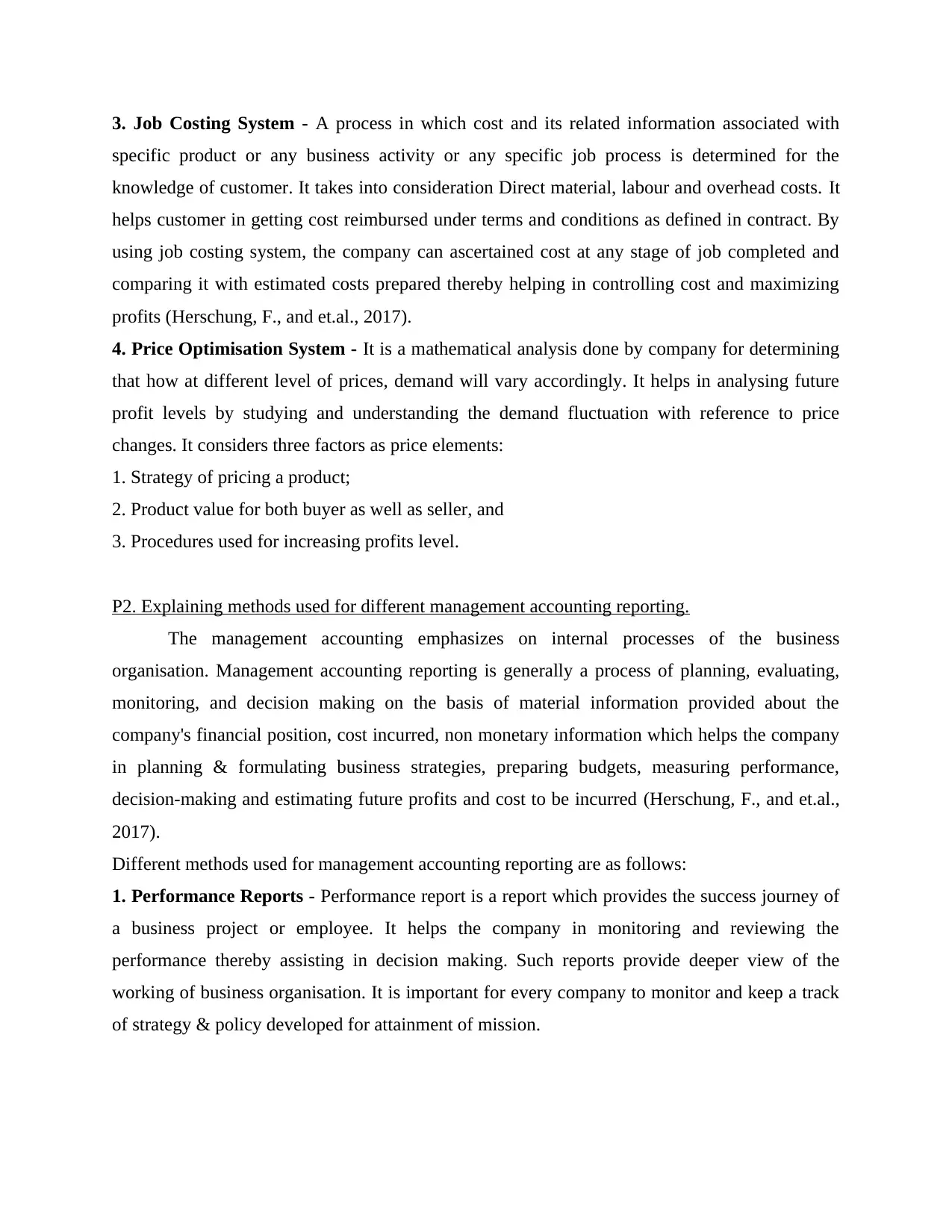
3. Job Costing System - A process in which cost and its related information associated with
specific product or any business activity or any specific job process is determined for the
knowledge of customer. It takes into consideration Direct material, labour and overhead costs. It
helps customer in getting cost reimbursed under terms and conditions as defined in contract. By
using job costing system, the company can ascertained cost at any stage of job completed and
comparing it with estimated costs prepared thereby helping in controlling cost and maximizing
profits (Herschung, F., and et.al., 2017).
4. Price Optimisation System - It is a mathematical analysis done by company for determining
that how at different level of prices, demand will vary accordingly. It helps in analysing future
profit levels by studying and understanding the demand fluctuation with reference to price
changes. It considers three factors as price elements:
1. Strategy of pricing a product;
2. Product value for both buyer as well as seller, and
3. Procedures used for increasing profits level.
P2. Explaining methods used for different management accounting reporting.
The management accounting emphasizes on internal processes of the business
organisation. Management accounting reporting is generally a process of planning, evaluating,
monitoring, and decision making on the basis of material information provided about the
company's financial position, cost incurred, non monetary information which helps the company
in planning & formulating business strategies, preparing budgets, measuring performance,
decision-making and estimating future profits and cost to be incurred (Herschung, F., and et.al.,
2017).
Different methods used for management accounting reporting are as follows:
1. Performance Reports - Performance report is a report which provides the success journey of
a business project or employee. It helps the company in monitoring and reviewing the
performance thereby assisting in decision making. Such reports provide deeper view of the
working of business organisation. It is important for every company to monitor and keep a track
of strategy & policy developed for attainment of mission.
specific product or any business activity or any specific job process is determined for the
knowledge of customer. It takes into consideration Direct material, labour and overhead costs. It
helps customer in getting cost reimbursed under terms and conditions as defined in contract. By
using job costing system, the company can ascertained cost at any stage of job completed and
comparing it with estimated costs prepared thereby helping in controlling cost and maximizing
profits (Herschung, F., and et.al., 2017).
4. Price Optimisation System - It is a mathematical analysis done by company for determining
that how at different level of prices, demand will vary accordingly. It helps in analysing future
profit levels by studying and understanding the demand fluctuation with reference to price
changes. It considers three factors as price elements:
1. Strategy of pricing a product;
2. Product value for both buyer as well as seller, and
3. Procedures used for increasing profits level.
P2. Explaining methods used for different management accounting reporting.
The management accounting emphasizes on internal processes of the business
organisation. Management accounting reporting is generally a process of planning, evaluating,
monitoring, and decision making on the basis of material information provided about the
company's financial position, cost incurred, non monetary information which helps the company
in planning & formulating business strategies, preparing budgets, measuring performance,
decision-making and estimating future profits and cost to be incurred (Herschung, F., and et.al.,
2017).
Different methods used for management accounting reporting are as follows:
1. Performance Reports - Performance report is a report which provides the success journey of
a business project or employee. It helps the company in monitoring and reviewing the
performance thereby assisting in decision making. Such reports provide deeper view of the
working of business organisation. It is important for every company to monitor and keep a track
of strategy & policy developed for attainment of mission.
⊘ This is a preview!⊘
Do you want full access?
Subscribe today to unlock all pages.

Trusted by 1+ million students worldwide
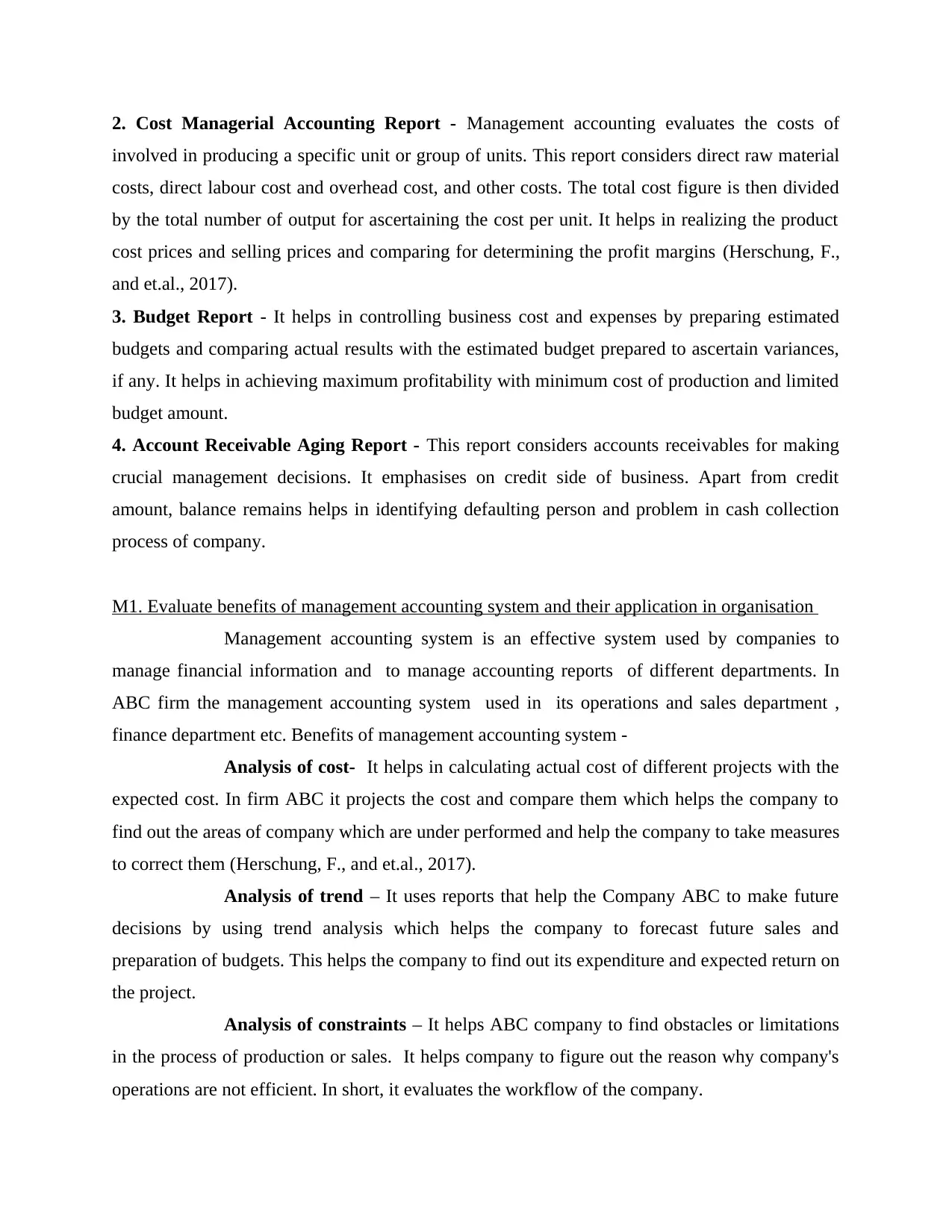
2. Cost Managerial Accounting Report - Management accounting evaluates the costs of
involved in producing a specific unit or group of units. This report considers direct raw material
costs, direct labour cost and overhead cost, and other costs. The total cost figure is then divided
by the total number of output for ascertaining the cost per unit. It helps in realizing the product
cost prices and selling prices and comparing for determining the profit margins (Herschung, F.,
and et.al., 2017).
3. Budget Report - It helps in controlling business cost and expenses by preparing estimated
budgets and comparing actual results with the estimated budget prepared to ascertain variances,
if any. It helps in achieving maximum profitability with minimum cost of production and limited
budget amount.
4. Account Receivable Aging Report - This report considers accounts receivables for making
crucial management decisions. It emphasises on credit side of business. Apart from credit
amount, balance remains helps in identifying defaulting person and problem in cash collection
process of company.
M1. Evaluate benefits of management accounting system and their application in organisation
Management accounting system is an effective system used by companies to
manage financial information and to manage accounting reports of different departments. In
ABC firm the management accounting system used in its operations and sales department ,
finance department etc. Benefits of management accounting system -
Analysis of cost- It helps in calculating actual cost of different projects with the
expected cost. In firm ABC it projects the cost and compare them which helps the company to
find out the areas of company which are under performed and help the company to take measures
to correct them (Herschung, F., and et.al., 2017).
Analysis of trend – It uses reports that help the Company ABC to make future
decisions by using trend analysis which helps the company to forecast future sales and
preparation of budgets. This helps the company to find out its expenditure and expected return on
the project.
Analysis of constraints – It helps ABC company to find obstacles or limitations
in the process of production or sales. It helps company to figure out the reason why company's
operations are not efficient. In short, it evaluates the workflow of the company.
involved in producing a specific unit or group of units. This report considers direct raw material
costs, direct labour cost and overhead cost, and other costs. The total cost figure is then divided
by the total number of output for ascertaining the cost per unit. It helps in realizing the product
cost prices and selling prices and comparing for determining the profit margins (Herschung, F.,
and et.al., 2017).
3. Budget Report - It helps in controlling business cost and expenses by preparing estimated
budgets and comparing actual results with the estimated budget prepared to ascertain variances,
if any. It helps in achieving maximum profitability with minimum cost of production and limited
budget amount.
4. Account Receivable Aging Report - This report considers accounts receivables for making
crucial management decisions. It emphasises on credit side of business. Apart from credit
amount, balance remains helps in identifying defaulting person and problem in cash collection
process of company.
M1. Evaluate benefits of management accounting system and their application in organisation
Management accounting system is an effective system used by companies to
manage financial information and to manage accounting reports of different departments. In
ABC firm the management accounting system used in its operations and sales department ,
finance department etc. Benefits of management accounting system -
Analysis of cost- It helps in calculating actual cost of different projects with the
expected cost. In firm ABC it projects the cost and compare them which helps the company to
find out the areas of company which are under performed and help the company to take measures
to correct them (Herschung, F., and et.al., 2017).
Analysis of trend – It uses reports that help the Company ABC to make future
decisions by using trend analysis which helps the company to forecast future sales and
preparation of budgets. This helps the company to find out its expenditure and expected return on
the project.
Analysis of constraints – It helps ABC company to find obstacles or limitations
in the process of production or sales. It helps company to figure out the reason why company's
operations are not efficient. In short, it evaluates the workflow of the company.
Paraphrase This Document
Need a fresh take? Get an instant paraphrase of this document with our AI Paraphraser
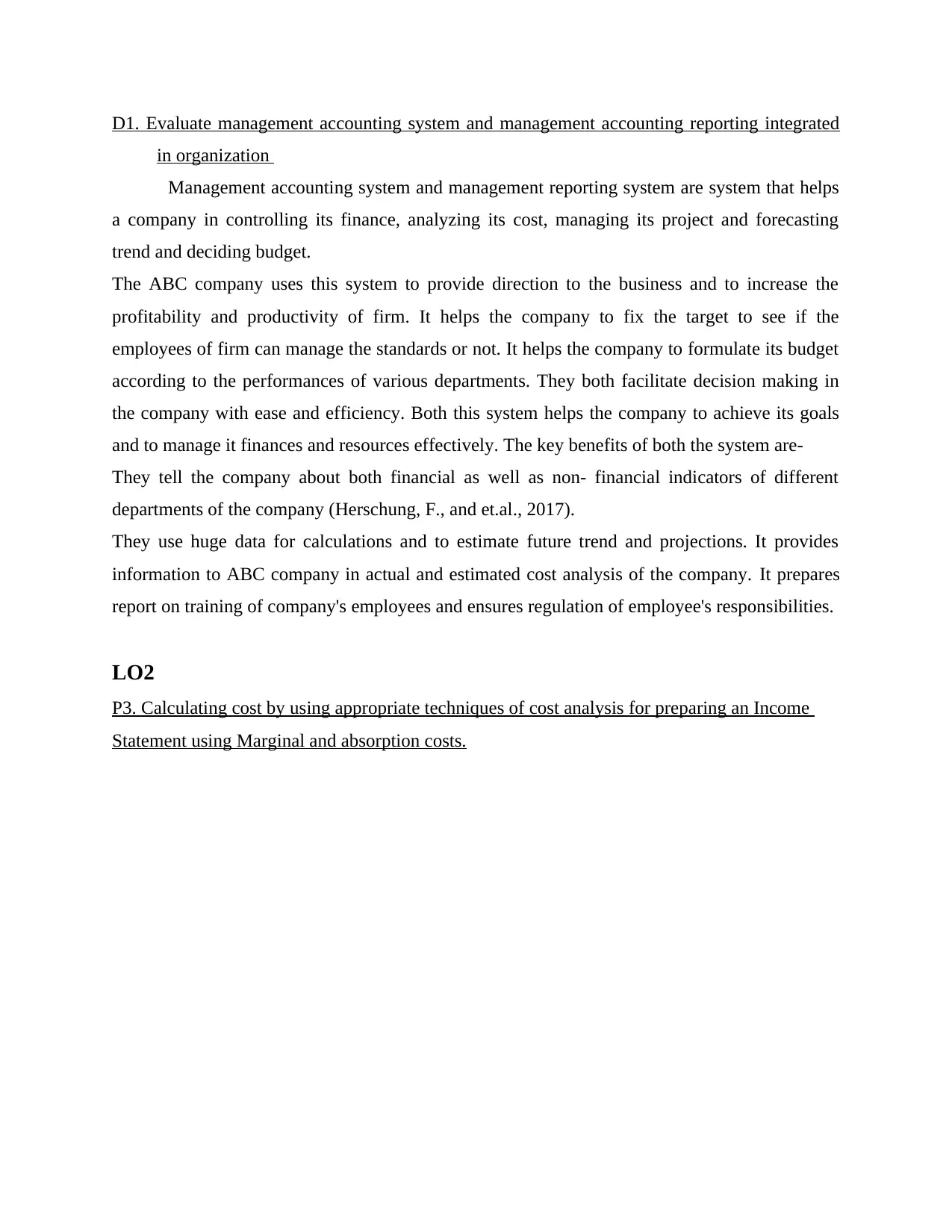
D1. Evaluate management accounting system and management accounting reporting integrated
in organization
Management accounting system and management reporting system are system that helps
a company in controlling its finance, analyzing its cost, managing its project and forecasting
trend and deciding budget.
The ABC company uses this system to provide direction to the business and to increase the
profitability and productivity of firm. It helps the company to fix the target to see if the
employees of firm can manage the standards or not. It helps the company to formulate its budget
according to the performances of various departments. They both facilitate decision making in
the company with ease and efficiency. Both this system helps the company to achieve its goals
and to manage it finances and resources effectively. The key benefits of both the system are-
They tell the company about both financial as well as non- financial indicators of different
departments of the company (Herschung, F., and et.al., 2017).
They use huge data for calculations and to estimate future trend and projections. It provides
information to ABC company in actual and estimated cost analysis of the company. It prepares
report on training of company's employees and ensures regulation of employee's responsibilities.
LO2
P3. Calculating cost by using appropriate techniques of cost analysis for preparing an Income
Statement using Marginal and absorption costs.
in organization
Management accounting system and management reporting system are system that helps
a company in controlling its finance, analyzing its cost, managing its project and forecasting
trend and deciding budget.
The ABC company uses this system to provide direction to the business and to increase the
profitability and productivity of firm. It helps the company to fix the target to see if the
employees of firm can manage the standards or not. It helps the company to formulate its budget
according to the performances of various departments. They both facilitate decision making in
the company with ease and efficiency. Both this system helps the company to achieve its goals
and to manage it finances and resources effectively. The key benefits of both the system are-
They tell the company about both financial as well as non- financial indicators of different
departments of the company (Herschung, F., and et.al., 2017).
They use huge data for calculations and to estimate future trend and projections. It provides
information to ABC company in actual and estimated cost analysis of the company. It prepares
report on training of company's employees and ensures regulation of employee's responsibilities.
LO2
P3. Calculating cost by using appropriate techniques of cost analysis for preparing an Income
Statement using Marginal and absorption costs.
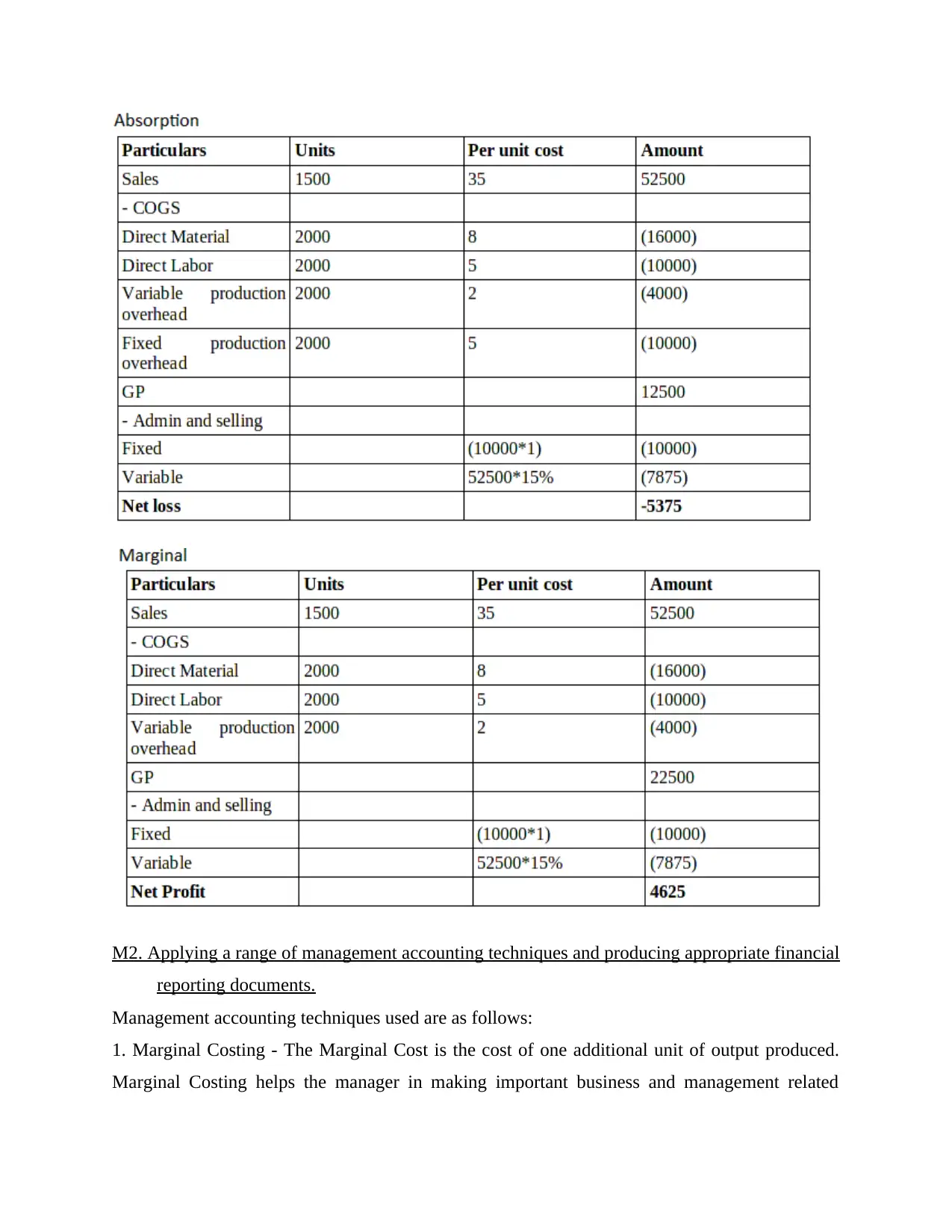
M2. Applying a range of management accounting techniques and producing appropriate financial
reporting documents.
Management accounting techniques used are as follows:
1. Marginal Costing - The Marginal Cost is the cost of one additional unit of output produced.
Marginal Costing helps the manager in making important business and management related
reporting documents.
Management accounting techniques used are as follows:
1. Marginal Costing - The Marginal Cost is the cost of one additional unit of output produced.
Marginal Costing helps the manager in making important business and management related
⊘ This is a preview!⊘
Do you want full access?
Subscribe today to unlock all pages.

Trusted by 1+ million students worldwide
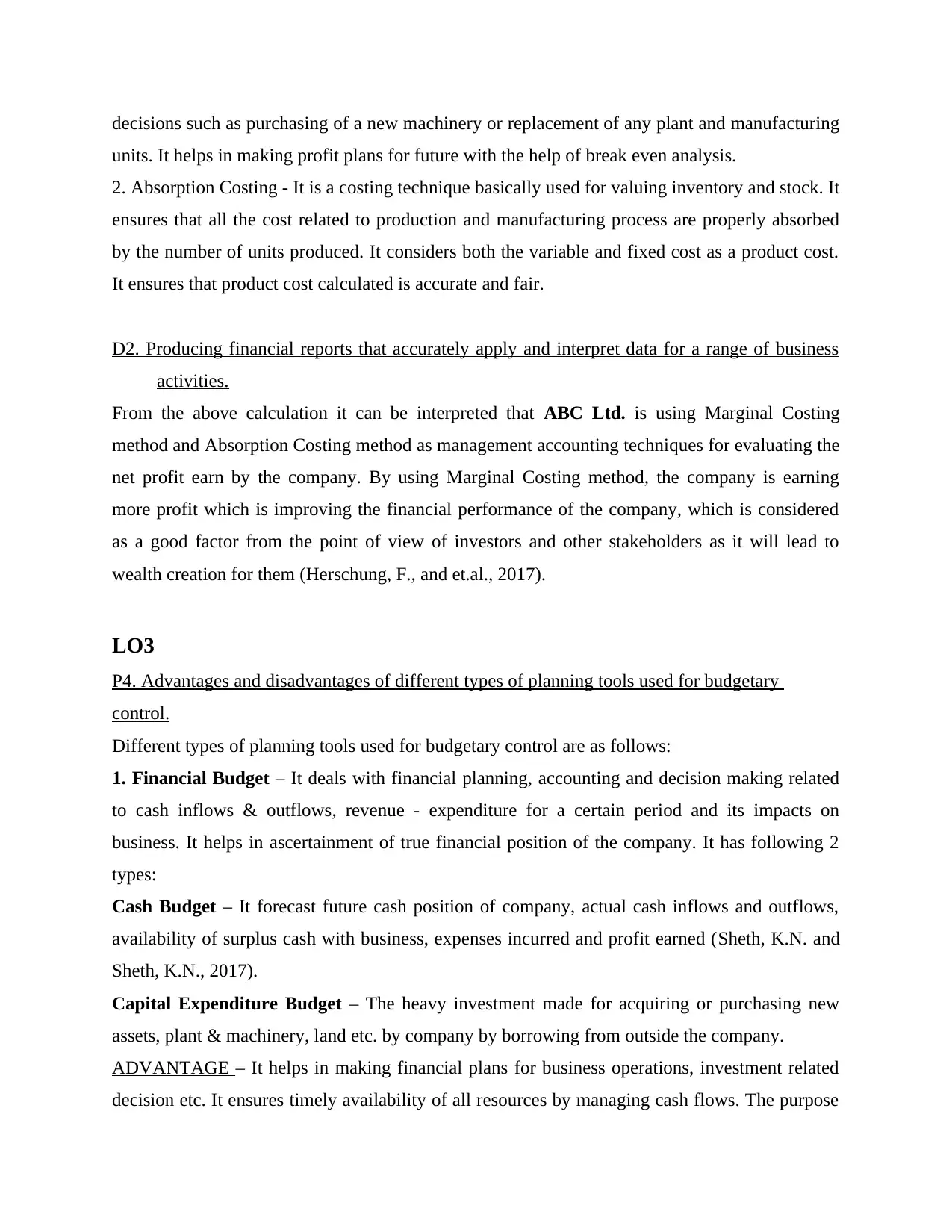
decisions such as purchasing of a new machinery or replacement of any plant and manufacturing
units. It helps in making profit plans for future with the help of break even analysis.
2. Absorption Costing - It is a costing technique basically used for valuing inventory and stock. It
ensures that all the cost related to production and manufacturing process are properly absorbed
by the number of units produced. It considers both the variable and fixed cost as a product cost.
It ensures that product cost calculated is accurate and fair.
D2. Producing financial reports that accurately apply and interpret data for a range of business
activities.
From the above calculation it can be interpreted that ABC Ltd. is using Marginal Costing
method and Absorption Costing method as management accounting techniques for evaluating the
net profit earn by the company. By using Marginal Costing method, the company is earning
more profit which is improving the financial performance of the company, which is considered
as a good factor from the point of view of investors and other stakeholders as it will lead to
wealth creation for them (Herschung, F., and et.al., 2017).
LO3
P4. Advantages and disadvantages of different types of planning tools used for budgetary
control.
Different types of planning tools used for budgetary control are as follows:
1. Financial Budget – It deals with financial planning, accounting and decision making related
to cash inflows & outflows, revenue - expenditure for a certain period and its impacts on
business. It helps in ascertainment of true financial position of the company. It has following 2
types:
Cash Budget – It forecast future cash position of company, actual cash inflows and outflows,
availability of surplus cash with business, expenses incurred and profit earned (Sheth, K.N. and
Sheth, K.N., 2017).
Capital Expenditure Budget – The heavy investment made for acquiring or purchasing new
assets, plant & machinery, land etc. by company by borrowing from outside the company.
ADVANTAGE – It helps in making financial plans for business operations, investment related
decision etc. It ensures timely availability of all resources by managing cash flows. The purpose
units. It helps in making profit plans for future with the help of break even analysis.
2. Absorption Costing - It is a costing technique basically used for valuing inventory and stock. It
ensures that all the cost related to production and manufacturing process are properly absorbed
by the number of units produced. It considers both the variable and fixed cost as a product cost.
It ensures that product cost calculated is accurate and fair.
D2. Producing financial reports that accurately apply and interpret data for a range of business
activities.
From the above calculation it can be interpreted that ABC Ltd. is using Marginal Costing
method and Absorption Costing method as management accounting techniques for evaluating the
net profit earn by the company. By using Marginal Costing method, the company is earning
more profit which is improving the financial performance of the company, which is considered
as a good factor from the point of view of investors and other stakeholders as it will lead to
wealth creation for them (Herschung, F., and et.al., 2017).
LO3
P4. Advantages and disadvantages of different types of planning tools used for budgetary
control.
Different types of planning tools used for budgetary control are as follows:
1. Financial Budget – It deals with financial planning, accounting and decision making related
to cash inflows & outflows, revenue - expenditure for a certain period and its impacts on
business. It helps in ascertainment of true financial position of the company. It has following 2
types:
Cash Budget – It forecast future cash position of company, actual cash inflows and outflows,
availability of surplus cash with business, expenses incurred and profit earned (Sheth, K.N. and
Sheth, K.N., 2017).
Capital Expenditure Budget – The heavy investment made for acquiring or purchasing new
assets, plant & machinery, land etc. by company by borrowing from outside the company.
ADVANTAGE – It helps in making financial plans for business operations, investment related
decision etc. It ensures timely availability of all resources by managing cash flows. The purpose
Paraphrase This Document
Need a fresh take? Get an instant paraphrase of this document with our AI Paraphraser
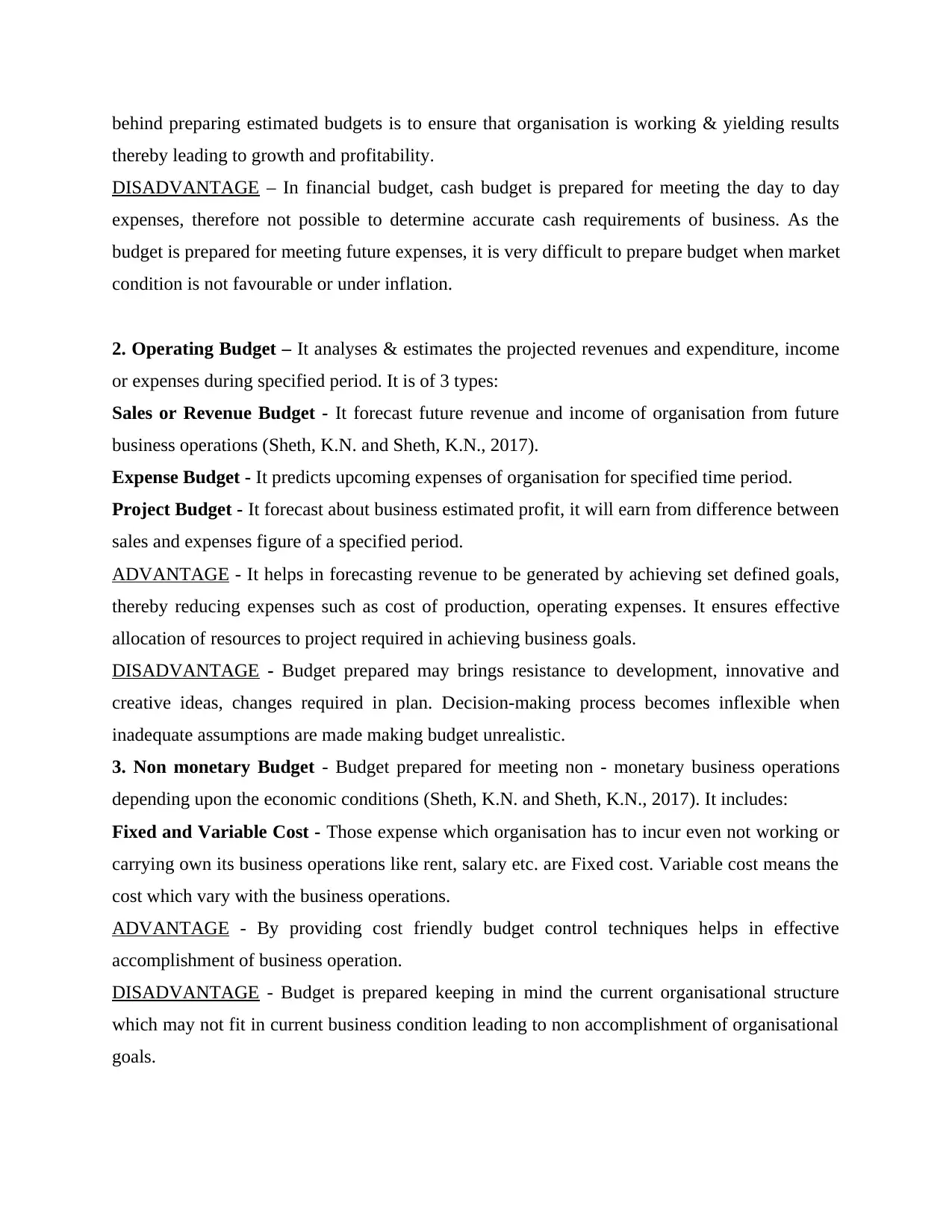
behind preparing estimated budgets is to ensure that organisation is working & yielding results
thereby leading to growth and profitability.
DISADVANTAGE – In financial budget, cash budget is prepared for meeting the day to day
expenses, therefore not possible to determine accurate cash requirements of business. As the
budget is prepared for meeting future expenses, it is very difficult to prepare budget when market
condition is not favourable or under inflation.
2. Operating Budget – It analyses & estimates the projected revenues and expenditure, income
or expenses during specified period. It is of 3 types:
Sales or Revenue Budget - It forecast future revenue and income of organisation from future
business operations (Sheth, K.N. and Sheth, K.N., 2017).
Expense Budget - It predicts upcoming expenses of organisation for specified time period.
Project Budget - It forecast about business estimated profit, it will earn from difference between
sales and expenses figure of a specified period.
ADVANTAGE - It helps in forecasting revenue to be generated by achieving set defined goals,
thereby reducing expenses such as cost of production, operating expenses. It ensures effective
allocation of resources to project required in achieving business goals.
DISADVANTAGE - Budget prepared may brings resistance to development, innovative and
creative ideas, changes required in plan. Decision-making process becomes inflexible when
inadequate assumptions are made making budget unrealistic.
3. Non monetary Budget - Budget prepared for meeting non - monetary business operations
depending upon the economic conditions (Sheth, K.N. and Sheth, K.N., 2017). It includes:
Fixed and Variable Cost - Those expense which organisation has to incur even not working or
carrying own its business operations like rent, salary etc. are Fixed cost. Variable cost means the
cost which vary with the business operations.
ADVANTAGE - By providing cost friendly budget control techniques helps in effective
accomplishment of business operation.
DISADVANTAGE - Budget is prepared keeping in mind the current organisational structure
which may not fit in current business condition leading to non accomplishment of organisational
goals.
thereby leading to growth and profitability.
DISADVANTAGE – In financial budget, cash budget is prepared for meeting the day to day
expenses, therefore not possible to determine accurate cash requirements of business. As the
budget is prepared for meeting future expenses, it is very difficult to prepare budget when market
condition is not favourable or under inflation.
2. Operating Budget – It analyses & estimates the projected revenues and expenditure, income
or expenses during specified period. It is of 3 types:
Sales or Revenue Budget - It forecast future revenue and income of organisation from future
business operations (Sheth, K.N. and Sheth, K.N., 2017).
Expense Budget - It predicts upcoming expenses of organisation for specified time period.
Project Budget - It forecast about business estimated profit, it will earn from difference between
sales and expenses figure of a specified period.
ADVANTAGE - It helps in forecasting revenue to be generated by achieving set defined goals,
thereby reducing expenses such as cost of production, operating expenses. It ensures effective
allocation of resources to project required in achieving business goals.
DISADVANTAGE - Budget prepared may brings resistance to development, innovative and
creative ideas, changes required in plan. Decision-making process becomes inflexible when
inadequate assumptions are made making budget unrealistic.
3. Non monetary Budget - Budget prepared for meeting non - monetary business operations
depending upon the economic conditions (Sheth, K.N. and Sheth, K.N., 2017). It includes:
Fixed and Variable Cost - Those expense which organisation has to incur even not working or
carrying own its business operations like rent, salary etc. are Fixed cost. Variable cost means the
cost which vary with the business operations.
ADVANTAGE - By providing cost friendly budget control techniques helps in effective
accomplishment of business operation.
DISADVANTAGE - Budget is prepared keeping in mind the current organisational structure
which may not fit in current business condition leading to non accomplishment of organisational
goals.
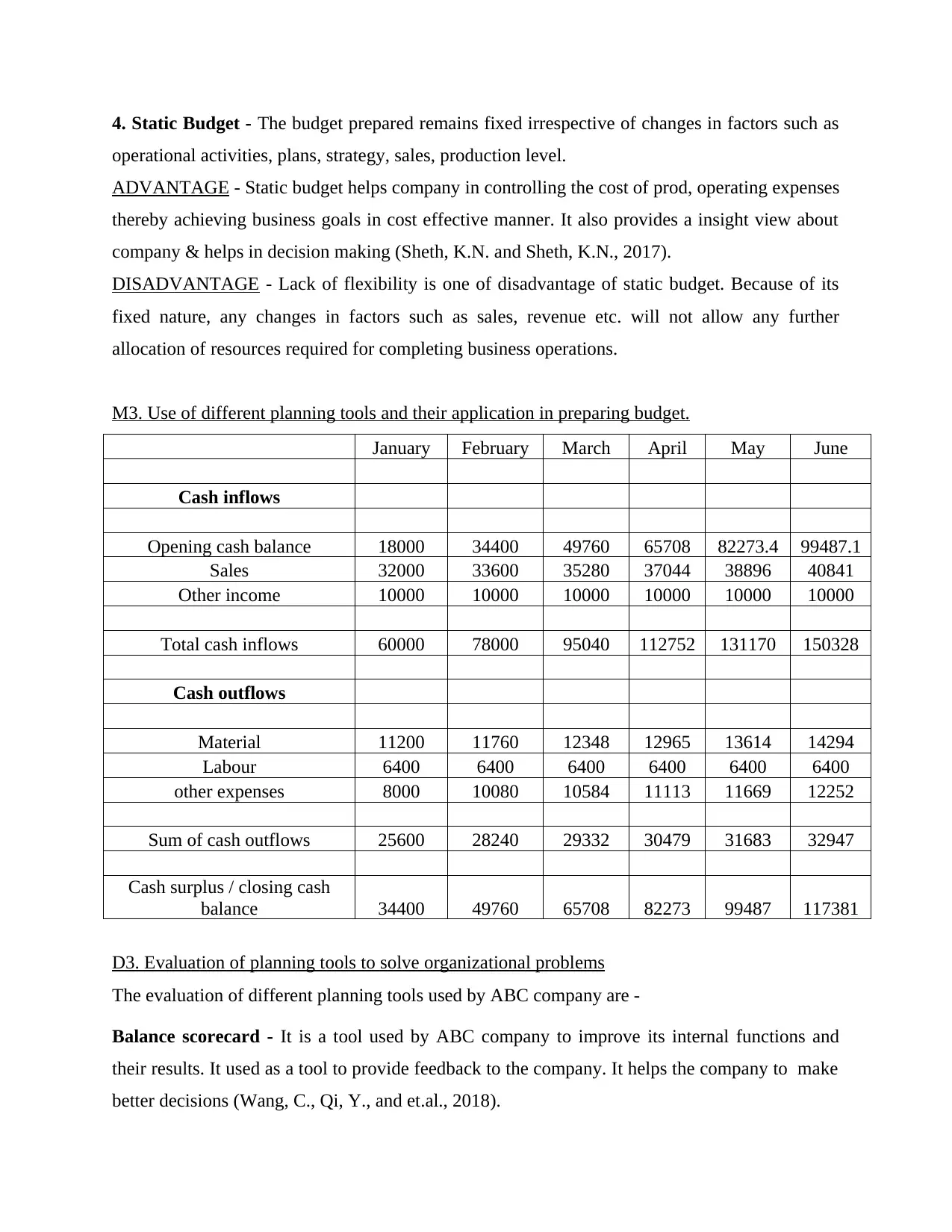
4. Static Budget - The budget prepared remains fixed irrespective of changes in factors such as
operational activities, plans, strategy, sales, production level.
ADVANTAGE - Static budget helps company in controlling the cost of prod, operating expenses
thereby achieving business goals in cost effective manner. It also provides a insight view about
company & helps in decision making (Sheth, K.N. and Sheth, K.N., 2017).
DISADVANTAGE - Lack of flexibility is one of disadvantage of static budget. Because of its
fixed nature, any changes in factors such as sales, revenue etc. will not allow any further
allocation of resources required for completing business operations.
M3. Use of different planning tools and their application in preparing budget.
January February March April May June
Cash inflows
Opening cash balance 18000 34400 49760 65708 82273.4 99487.1
Sales 32000 33600 35280 37044 38896 40841
Other income 10000 10000 10000 10000 10000 10000
Total cash inflows 60000 78000 95040 112752 131170 150328
Cash outflows
Material 11200 11760 12348 12965 13614 14294
Labour 6400 6400 6400 6400 6400 6400
other expenses 8000 10080 10584 11113 11669 12252
Sum of cash outflows 25600 28240 29332 30479 31683 32947
Cash surplus / closing cash
balance 34400 49760 65708 82273 99487 117381
D3. Evaluation of planning tools to solve organizational problems
The evaluation of different planning tools used by ABC company are -
Balance scorecard - It is a tool used by ABC company to improve its internal functions and
their results. It used as a tool to provide feedback to the company. It helps the company to make
better decisions (Wang, C., Qi, Y., and et.al., 2018).
operational activities, plans, strategy, sales, production level.
ADVANTAGE - Static budget helps company in controlling the cost of prod, operating expenses
thereby achieving business goals in cost effective manner. It also provides a insight view about
company & helps in decision making (Sheth, K.N. and Sheth, K.N., 2017).
DISADVANTAGE - Lack of flexibility is one of disadvantage of static budget. Because of its
fixed nature, any changes in factors such as sales, revenue etc. will not allow any further
allocation of resources required for completing business operations.
M3. Use of different planning tools and their application in preparing budget.
January February March April May June
Cash inflows
Opening cash balance 18000 34400 49760 65708 82273.4 99487.1
Sales 32000 33600 35280 37044 38896 40841
Other income 10000 10000 10000 10000 10000 10000
Total cash inflows 60000 78000 95040 112752 131170 150328
Cash outflows
Material 11200 11760 12348 12965 13614 14294
Labour 6400 6400 6400 6400 6400 6400
other expenses 8000 10080 10584 11113 11669 12252
Sum of cash outflows 25600 28240 29332 30479 31683 32947
Cash surplus / closing cash
balance 34400 49760 65708 82273 99487 117381
D3. Evaluation of planning tools to solve organizational problems
The evaluation of different planning tools used by ABC company are -
Balance scorecard - It is a tool used by ABC company to improve its internal functions and
their results. It used as a tool to provide feedback to the company. It helps the company to make
better decisions (Wang, C., Qi, Y., and et.al., 2018).
⊘ This is a preview!⊘
Do you want full access?
Subscribe today to unlock all pages.

Trusted by 1+ million students worldwide
1 out of 18
Related Documents
Your All-in-One AI-Powered Toolkit for Academic Success.
+13062052269
info@desklib.com
Available 24*7 on WhatsApp / Email
![[object Object]](/_next/static/media/star-bottom.7253800d.svg)
Unlock your academic potential
Copyright © 2020–2025 A2Z Services. All Rights Reserved. Developed and managed by ZUCOL.





